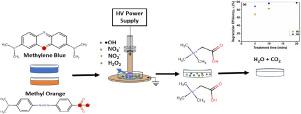DBD plasma induced degradation of anionic and cationic dyes: An insight into the fragmentation pathway of dye degradation
IF 7.1
Q1 ENGINEERING, CHEMICAL
引用次数: 0
Abstract
The degradation of an anionic (Methyl Orange, MO) and a cationic (Methylene Blue, MB) dye using dielectric barrier discharge cold atmospheric plasma (DBD-CAP) was investigated. It was observed that the plasma generated reactive oxygen and nitrogen species (RONS), leading to the breakdown of dye chromophores and aromatic structures. Systematic analysis using UV–Vis spectroscopy, FTIR, and LC-MS/MS confirmed the degradation of 97% for both dyes within 20 minutes of plasma exposure. The LC-MS/MS spectra revealed intermediate compounds and key degradation pathways, including azo bond cleavage, aromatic ring opening, and formation of aliphatic fragments. The proposed mechanism elucidates the stepwise breakdown into benign products such as CO2, H2O, and inorganic ions. The study demonstrated the potential of DBD-CAP as a green, efficient technology for industrial wastewater remediation, providing insights into plasma-induced molecular fragmentation and degradation kinetics of persistent organic pollutants.

DBD等离子体诱导阴离子和阳离子染料的降解:对染料降解的碎片化途径的洞察
研究了介质阻挡放电冷常压等离子体(DBD-CAP)对阴离子(甲基橙,MO)和阳离子(亚甲基蓝,MB)染料的降解效果。观察到等离子体产生活性氧和活性氮(RONS),导致染料发色团和芳香结构的分解。使用紫外可见光谱、红外光谱和LC-MS/MS进行系统分析,证实两种染料在等离子体暴露20分钟内降解率为97%。LC-MS/MS光谱揭示了中间化合物和关键降解途径,包括偶氮键裂解、芳环打开和脂肪片段的形成。提出的机制阐明了逐步分解成良性产物,如CO2, H2O和无机离子。该研究证明了DBD-CAP作为一种绿色、高效的工业废水修复技术的潜力,为等离子体诱导的分子断裂和持久性有机污染物的降解动力学提供了见解。
本文章由计算机程序翻译,如有差异,请以英文原文为准。
求助全文
约1分钟内获得全文
求助全文
来源期刊

Chemical Engineering Journal Advances
Engineering-Industrial and Manufacturing Engineering
CiteScore
8.30
自引率
0.00%
发文量
213
审稿时长
26 days
 求助内容:
求助内容: 应助结果提醒方式:
应助结果提醒方式:


